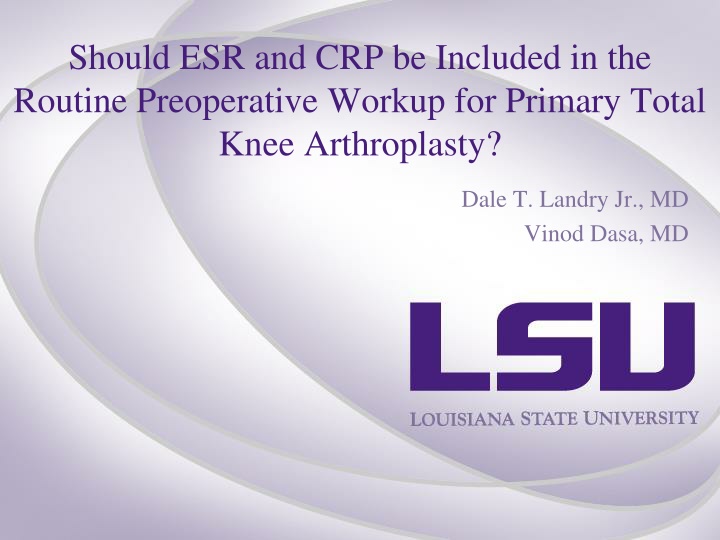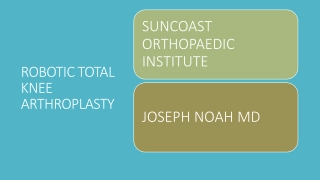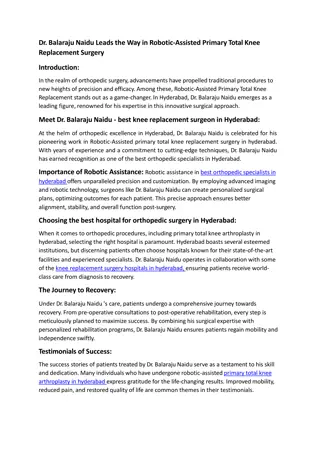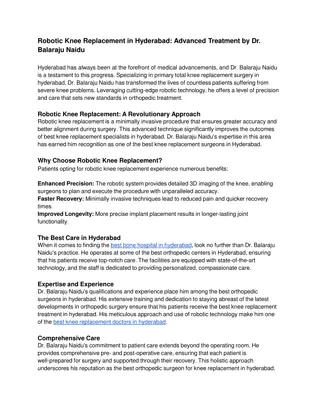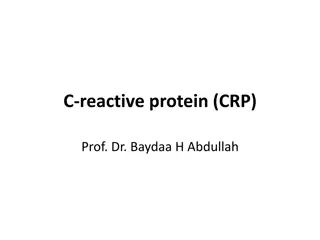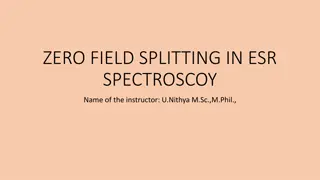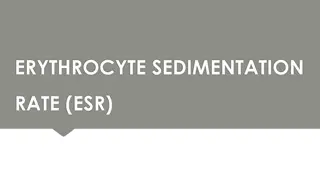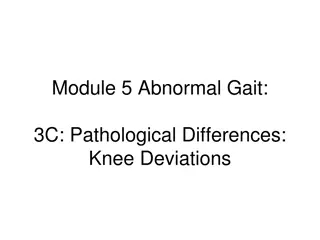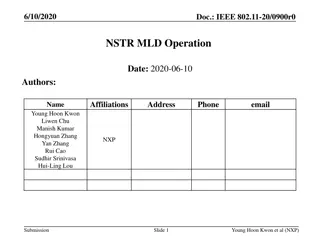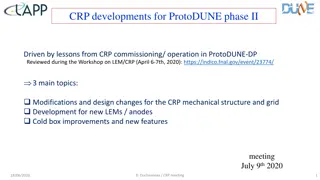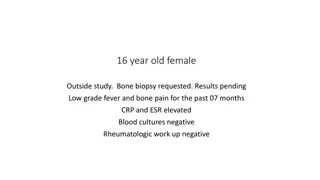The Role of ESR and CRP in Preoperative Workup for Total Knee Arthroplasty
Preoperative assessment for primary total knee arthroplasty should consider including ESR and CRP levels as routine tests due to their accuracy in diagnosing periprosthetic joint infection (PJI). Elevated postoperative ESR/CRP levels can serve as predictors of PJI, aiding in prompt diagnosis and treatment. Understanding the normal trends of ESR and CRP post-surgery is crucial in monitoring patient recovery and identifying potential complications such as aseptic loosening. Incorporating these simple and cost-effective tests in the preoperative workup can enhance the management of patients undergoing total knee arthroplasty.
Download Presentation

Please find below an Image/Link to download the presentation.
The content on the website is provided AS IS for your information and personal use only. It may not be sold, licensed, or shared on other websites without obtaining consent from the author.If you encounter any issues during the download, it is possible that the publisher has removed the file from their server.
You are allowed to download the files provided on this website for personal or commercial use, subject to the condition that they are used lawfully. All files are the property of their respective owners.
The content on the website is provided AS IS for your information and personal use only. It may not be sold, licensed, or shared on other websites without obtaining consent from the author.
E N D
Presentation Transcript
Should ESR and CRP be Included in the Routine Preoperative Workup for Primary Total Knee Arthroplasty? Dale T. Landry Jr., MD Vinod Dasa, MD
Disclosures Dale T. Landry Jr., MD None Vinod Dasa, MD Paid Consultant Bioventus Myoscience Stock Pacira Research Support Cropper Medical Department of Defense
Background Periprosthetic Joint Infection (PJI) Most devastating complication of total joint arthroplasty Most common reason for total knee arthroplasty 1 1% - 3% incidence with Primary Osteoarthritis 2-3 2% - 4% incidence with Rheumatoid Arthritis 4-5 3% - 7% incidence with Diabetes 6-7 Cost of treatment of PJI over $50,000 per patient 8 Overall yearly cost of greater than $300,000,000 2-3, 8 1. 2. Bozic KJ, et.al. The epidemiology of revision total knee arthroplasty in the United States. Clin Orthop Relat Res. 2010;468:45-51. Phillips JE, et.al.. The incidence of deep prosthetic infections in a specialist orthopaedic hospital: a 15-year prospective survey. J Bone Joint Surg Br. 2006;88:943-8. Della Valle CJ, et.al. PE. Periprosthetic sepsis. Clin Orthop Relat Res. 2004;420:26-31. Wilson, M. G.; et.al.. Infection as a complication of total knee-replacement arthroplasty. Risk factors and treatment in sixty-seven cases. J. Bone and Joint Surg., 12-A: 878-883, July 1990 Poss, R.; et.al.. Factors influencing the incidence and outcome of infection following total joint arthroplasty. Clin. Orthop., 182:117- 126,1984. England, S. P.; et.al.. Total knee arthroplasty in diabetes mellitus. Clin. Orthop., 260: 130-134,1990. Papagelopoulos, P, et.al.. Long term outcome and survivorship analysis of primary total knee arthroplasty in patients with diabetes mellitus. Clin. Orthop., 330:124-132,1996. Maderazo, E. G.; et.al. Late infections of total joint prostheses. A review and recommendations for prevention. Clin. Orthop., 229:131- 142,1988 3. 4. 5. 6. 7. 8.
Background Erythrocyte Sedimentation Rate (ESR) & C-Reactive Protein (CRP) Simple, inexpensive, readily available, and accurate Measures of the Acute Phase Reaction Diagnosis of PJI Treatment of PJI by following the trends ESR/CRP in combination are effective tools for helping diagnose PJI Postop elevated levels of ESR/CRP are predictors of PJI 9-11 Normal trends of ESR/CRP following THA/TKA are well-studied 9. 10. Greidanus NV, et.al.. Use of erythrocyte sedimentation rate and C-reactive protein level to diagnose infection before revision total knee arthroplasty. A prospective evaluation. J Bone Joint Surg Am. 2007;89:1409-16. 11. Parvizi J, et.al.. Diagnosis of infected total knee: findings of a multicenter database. Clin Orthop Relat Res. 2008;466:2628-33.. Della Valle C, et.al.. Preoperative testing for sepsis before revision total knee arthroplasty. J Arthroplasty. 2007;22(6 Suppl. 2):90-3.
Background Erythrocyte Sedimentation Rate (ESR) 12-13 Peaks on post-op day 5 Returns to normal at 7-9 months with TKA C-Reactive Protein (CRP) 14-15 Peaks on post-op day 2 Returns to normal by 3-4 weeks with TKA Remains WNL for aseptic loosening 16 ESR/CRP nonspecific for PJI, and can be elevated in a number of other medical conditions 17 12. Park KK, et.al: Normative Temporal Values of CRP and ESR in Unilateral and Staged Bilateral TKA. Clin Orthop Relat Res. 2008 Jan;466(1):179-88. Epub 2008 Jan 3. 13. Bilgen O, et.al..: C-reactive protein values and erythrocyte sedimentation rates after total hip and total knee arthroplasty. J Int Med Res. 2001 Jan-Feb;29(1):7-12 14. Larsson S, et.al..: C-reactive protein (CRP) levels after elective orthopedic surgery. Clin Orthop Relat Res. 1992 Feb;(275):237-42. 15. Niskanen, R. O, et.al., H.: Serum C-reactive protein levels after total hip and knee arthroplasty. J. Bone and Joint Surg., 78-B(3): 431- 433,1996. 16. Shih, L.-Y., et.al.: Erythrocyte sedimentation rate and C-reactive protein values in patients with total hip arthroplasty. Clin. Orthop., 225:238- 246,1987. 17. Nielen M, et.al.. Increased levels of C-reactive protein in serum from blood donors before the onset of rheumatoid arthritis. Arthritis & Rheumatology. 2004; 50: 2423 2427
Background Sensitivity for PJI 18-19 Elevated ESR .82 Elevated CRP .96 Excellent Negative Predictive Value when both are WNL Combination of ESR/CRP shown to be a cost-effective screening protocol for diagnosis of PJI 20 Similar findings of the usefulness of combined ESR and CRP in the setting of PJI following TKA or THA have been reported 21-22 18. Spangehl MJ, et. al.. Prospective analysis of preoperative and intraoperative investigations for the diagnosis of infection at the sites of two hundred and two revision total hip arthroplasties. J Bone Joint Surg Am. 1999 May;81(5):672-83 19. Greidanus NV, et. al.. Use of erythrocyte sedimentation rate and C-reactive protein level to diagnose infection before revision total knee arthroplasty. A prospective evaluation. J Bone Joint Surg Am. 2007 Jul;89(7):1409-16. 20. Austin MS, et. al. .: A simple, cost-effective screening protocol to rule out periprosthetic infection. J Arthroplasty. 2008 Jan; 23(1):65-8 21. Bernard L, et. al.: Value of preoperative investigations in diagnosing prosthetic joint infection: retrospective cohort study and literature review. Scand J Infect Dis. 2004;36(6-7):410-6. 22. Schinsky M, Della Valle C. Perioperative testing for joint infection in patients undergoing revision total hip arthroplasty. J Bone Joint Surg Am. 2008; 90: 1869 1875.
Background Normal Range of ESR 23-24 Patient < 50 yrs Males < 15 mm/hr Females < 25 mm/hr Patient > 50 yrs Males < 20 mm/hr Females < 30mm/hr Normal Range of CRP 25 CRP < 8.2mg/L 23. Caswell M. Effect of patient age on tests of the acute-phase response. Arch Pathol Lab Med 1993;117:906 909 24. Bottinger LE, et. al. Normal erythrocyte sedimentation rate and age. Br Med J. 1967 Apr 8;2(5544):85-7 25. Shine B, et. al.. Solid-Phase Radioimmunoassays for C-reactive protein. Clin. Chim. Acta. 1981; 117:13 23.
Background However, patients undergoing Total Knee Arthroplasty have other comorbid medical conditions that may affect ESR/CRP Urinary Tract Infection 26 Rheumatoid Arthritis 27 Hepatitis-C 28 Crohn s Disease 29 Systemic Lupus Erythematosis 30 Psoriasis 31 Obesity 32 26. Rohrmann S, et. al. Serum C-reactive protein concentration and lower urinary tract symptoms in older men in the Third National Health and Nutrition Examination Survey (NHANES III). The Prostate. 2005; 62: 27 33. Nielen M, et. al.. Increased levels of C-reactive protein in serum from blood donors before the onset of rheumatoid arthritis. Arthritis & Rheumatology. 2004; 50: 2423 2427. Salter M, et. al.. Correlates of Elevated Interleukin-6 and C-Reactive Protein in Persons With or at High Risk for HCV and HIV Infections. Journal of Acquired Immune Deficiency Syndromes. 2013; 24: 488 495. Fagan E, et. al.. Serum levels of C-reactive protein in Crohn's disease and ulcerative colitis. European Journal of Clinical Investigation. 1982; 12: 351 359. Borg E, et. al. C-reactive protein levels during disease exacerbations and infections in systemic lupus erythematosus: a prospective longitudinal study. The Journal of Rheumatology. 1990; 17: 1642 1648 Stern, S. H.; et. al.. Total knee arthroplasty in patients with psoriasis. Clin. Orthop., 248:108-111,1989. Wilson, M. Get. Al.. Infection as a complication of total knee-replacement arthroplasty. Risk factors and treatment in sixty-seven cases. J. Bone and Joint Surg., 12-A: 878-883, July 1990 27. 28. 29. 30. 31. 32.
Background Little data exists on interpretation of preoperative Elevated ESR/CRP No data exists on how to interpret postoperatively elevated ESR/CRP levels in the setting of preoperative elevation
Study Purpose Primary Define the prevalence of preoperatively elevated ESR and CRP within a cohort of healthy patients undergoing primary Total Knee Arthroplasty Secondary Define any comorbidities that may contribute to preoperatively elevated ESR and CRP
Materials & Methods Retrospective chart review of patients who underwent Primary TKA with one surgeon between October 2009 May 2011 Demographics Including Age Gender BMI Medical Comorbidities Pre-Op Lab Values Recorded CRP ESR WBC
Materials & Methods Overall Cohort Inclusion Criteria Total Knee Arthroplasty from October 2007 May 2011 Pre-Op Labs Within 30 Days of Procedure WBC/ESR/CRP At Least Six Months of Follow-Up 94 Patients Idiopathic Cohort Exclusion Criteria Previous Arthroplasty Performed Pre-Op Infection/UTI Chronic Inflammatory Process 78 Patients
Results Overall Cohort Elevated ESR 41.5% (31/94) Elevated CRP 28.7% (27/94) Idiopathic Cohort Elevated ESR 38.5% (30/78) Elevated CRP 26.9% (21/78)
Comparison of Overall Cohort and Idiopathic Cohort of Elevated ESR/CRP by Percent vs BMI (kg/m2) Patients with BMI of 18.5 24.9 0% Elevated ESR 0% Elevated CRP Patients with BMI of 25 29.9 23.5% Elevated ESR 11.8% Elevated CRP Patients with BMI of 30 39.9 36 % Elevated ESR 19.5% Elevated CRP Patients with BMI > 40 64.7% Elevated ESR 64.7% Elevated CRP
Comparison in Idiopathic Cohort of BMI Classification to Mean ESR and CRP
Conclusions Significant number of otherwise healthy patients undergoing TKA with idiopathically elevated ESR/CRP Elevated ESR 38.5% Elevated CRP 26.9% It is inappropriate to assume that an otherwise healthy patient has a normal ESR/CRP prior to undergoing primary joint arthroplasty
Conclusions Direct correlation between BMI category and ESR/CRP Preoperatively, as patient s BMI category increases, one should assume that their ESR/CRP levels are likely elevated Patients with BMI of 18.5 24.9 kg/m2 0% Elevated ESR 0% Elevated CRP Patients with BMI of 25 29.9 kg/m2 23.5% Elevated ESR 11.8% Elevated CRP Patients with BMI of 30 39.9 kg/m2 36 % Elevated ESR 19.5% Elevated CRP Patients with BMI > 40 kg/m2 64.7% Elevated ESR 64.7% Elevated CRP
Conclusions As BMI category increases, so to does the mean of both elevated ESR/CRP as well as the mean of normal ESR/CRP If periprosthetic infection is present, what threshold ESR/CRP levels in different BMI classes should be used to determine infection clearance and timeliness of arthroplasty re-implantation? Suggests that large scale prospective studies should be performed to determine more accurate BMI category-specific normal reference ranges for ESR/CRP
Conclusions Until the results of this study are validated or refuted with large scale trials, one should consider attaining preoperative ESR/CRP values on all patients undergoing joint arthroplasty Cheap & Readily available May help put elevated post-op ESR/CRP values into perspective in a patient with a painful arthroplasty Do these elevated values represent true periprosthetic infection? Are these lab values being interpreted as elevated when in fact they are WNL with respect to the patient s BMI?
Acknowledgments Vinod Dasa, MD Louisiana State University Health Sciences Center Department of Orthopaedic Surgery Ochsner Medical Center Kenner
References 1. Bozic KJ, Kurtz SM, Lau E, Ong K, Chiu V, Vail TP, Rubash HE, Berry DJ. The epidemiology of revision total knee arthroplasty in the United States. Clin Orthop Relat Res. 2010;468:45-51. Bozic KJ, Kurtz SM, Lau E, Ong K, Vail TP, Berry DJ. The epidemiology of revision total hip arthroplasty in the United States. J Bone Joint Surg Am. 2009;91:128-33. Maderazo, E. G.; Judson, S.; and Pasternak, H.: Late infections of total joint prostheses. A review and recommendations for prevention. Clin. Orthop., 229:131-142,1988 Phillips JE, Crane TP, Noy M, Elliott TS, Grimer RJ. The incidence of deep prosthetic infections in a specialist orthopaedic hospital: a 15-year prospective survey. J Bone Joint Surg Br. 2006;88:943-8. Della Valle CJ, Zuckerman JD, Di Cesare PE. Periprosthetic sepsis. Clin Orthop Relat Res. 2004;420:26-31. Peersman G, Laskin R, Davis J, PetersonM. Infection in total knee replacement: a retrospective review of 6489 total knee replacements. Clin Orthop Relat Res. 2001; 392:15-23. J amsen E, Varonen M, Huhtala H, Lehto MU, Lumio J, Konttinen YT, Moilanen T. Incidence of prosthetic joint infections after primary knee arthroplasty. J Arthroplasty. 2010;25:87-92. Kurtz SM, Lau E, Schmier J, Ong KL, Zhao K, Parvizi J. Infection burden for hip and knee arthroplasty in the United States. J Bone Joint Surg Am. 2008;23:984-91. Mason JB, Fehring TK,OdumSM, GriffinWL, Nussman DS. The value of white blood cell counts before revision total knee arthroplasty. J Arthroplasty. 2003;18:1038-43. 10. Della Valle CJ, Sporer SM, Jacobs JJ, Berger RA, Rosenberg AG, Paprosky WG. Preoperative testing for sepsis before revision total knee arthroplasty. J Arthroplasty. 2007;22(6 Suppl. 2):90-3. 2. 3. 4. 5. 6. 7. 8. 9.
References 11. Greidanus NV, Masri BA, Garbuz DS, Wilson SD, McAlinden MG, Xu M, Duncan CP. Use of erythrocyte sedimentation rate and C-reactive protein level to diagnose infection before revision total knee arthroplasty. A prospective evaluation. J Bone Joint Surg Am. 2007;89:1409-16. 12. Parvizi J, Ghanem E, Sharkey P, Aggarwal A, Burnett RS, Barrack RL. Diagnosis of infected total knee: findings of a multicenter database. Clin Orthop Relat Res. 2008;466:2628-33. 13. Caswell M. Effect of patient age on tests of the acute-phase response. Arch Pathol Lab Med 1993;117:906 909. 14. Shine B, de Beer F. Solid-Phase Radioimmunoassays for C-reactive protein. Clin. Chim. Acta. 1981; 117:13 23. 15. Rohrmann S, De Marzo A. Serum C-reactive protein concentration and lower urinary tract symptoms in older men in the Third National Health and Nutrition Examination Survey (NHANES III). The Prostate. 2005; 62: 27 33. 16. Nielen M, Schaardenburg D. Increased levels of C-reactive protein in serum from blood donors before the onset of rheumatoid arthritis. Arthritis & Rheumatology. 2004; 50: 2423 2427. 17. Salter M, Lau B. Correlates of Elevated Interleukin-6 and C-Reactive Protein in Persons With or at High Risk for HCV and HIV Infections. Journal of Acquired Immune Deficiency Syndromes. 2013; 24: 488 495. 18. Fagan E, Dyck R. Serum levels of C-reactive protein in Crohn's disease and ulcerative colitis. European Journal of Clinical Investigation. 1982; 12: 351 359. 19. Borg E, Horst G. C-reactive protein levels during disease exacerbations and infections in systemic lupus erythematosus: a prospective longitudinal study. The Journal of Rheumatology. 1990; 17: 1642 1648
References 20. Vessely MB, Whaley AL, Harmsen WS, Schleck CD, Berry DJ. Long-term survivorship and failure modes of 1000 cemented condylar total knee arthroplasties. Clin Orthop Relat Res. 2006 Nov;452:28-34. 21. Fehring TK, Odum S, Griffin WL, Mason JB, Nadaud M. Early failures in total knee arthroplasty. Clin Orthop Relat Res. 2001 Nov;(392):315-8. 22. Wilson, M. G.; Kelley, K.; and Thornhill, T. S. Infection as a complication of total knee-replacement arthroplasty. Risk factors and treatment in sixty-seven cases. J. Bone and Joint Surg., 12-A: 878-883, July 1990 23. Poss, R.; Thornhill, T. S.; Ewald, F. C; Thomas, W. H.; Batte, N. J.; and Sledge, C. B. Factors influencing the incidence and outcome of infection following total joint arthroplasty. Clin. Orthop., 182:117-126,1984. 24. England, S. P.; Stern, S. H.; Insall, J. N.; and Windsor, R. E. Total knee arthroplasty in diabetes mellitus. Clin. Orthop., 260: 130-134,1990. 25. Papagelopoulos, P. J.; Idusuyi, O. B.; Wallrichs, S. L.; and Morrey, B. F. Long term outcome and survivorship analysis of primary total knee arthroplasty in patients with diabetes mellitus. Clin. Orthop., 330:124-132,1996. 26. Rand, J. A., and Fitzgerald, R. H., Jr. Diagnosis and management of the infected total knee arthroplasty. Orthop. Clin. North America, 20:201-210,1989. 27. Greene, K. A.; Wilde, A. N.; and Stulberg, B. N. Preoperative nutritional status of total joint patients. Relationship to postoperative wound complications. J. Arthroplasty, 6: 321-325,1991
References 28. Jensen, J. E.; Jensen, T. G.; Smith, T. K.; Johnston, D. A.; and Dudrick, S. J. Nutrition in orthopaedic surgery. J. Bone and Joint Surg., 64-A: 1263-1272, Dec. 1982. 29. Smith, T. K.: Nutrition: its relationship to orthopedic infections. Orthop. Clin. North America, 22:373- 377,1991 30. Gherini, S.; Vaughn, B. K.; Lombardi, A. V., Jr.; and Mallory, T. H. Delayed wound healing and nutritional deficiencies after total hip arthroplasty. Clin. Orthop., 293:188-195,1993. 31. Stern, S. H.; Insall, J. N.; Windsor, R. H.; Inglis, A. E.; and Dines, D. M. Total knee arthroplasty in patients with psoriasis. Clin. Orthop., 248:108-111,1989. 32. Park KK, Kim TK, Chang CB, Yoon SW, Park KU.: Normative Temporal Values of CRP and ESR in Unilateral and Staged Bilateral TKA. Clin Orthop Relat Res. 2008 Jan;466(1):179-88. Epub 2008 Jan 3. 33. Larsson S, Thelander U, Friberg S.: C-reactive protein (CRP) levels after elective orthopedic surgery. Clin Orthop Relat Res. 1992 Feb;(275):237-42. 34. Bilgen O, Atici T, Durak K, Karaemino ullari, Bilgen MS.: C-reactive protein values and erythrocyte sedimentation rates after total hip and total knee arthroplasty. J Int Med Res. 2001 Jan-Feb;29(1):7-12 35. Niskanen, R. O.; Korkala, O.; and Pammo, H.: Serum C-reactive protein levels after total hip and knee arthroplasty. J. Bone and Joint Surg., 78-B(3): 431-433,1996. 36. Shih, L.-Y.; Wu, J.-J.; and Yang, D.-J.: Erythrocyte sedimentation rate and C-reactive protein values in patients with total hip arthroplasty. Clin. Orthop., 225:238-246,1987. 37. Austin MS, Ghanem E, Joshi A, Lindsay A, Parvizi J.: A simple, cost-effective screening protocol to rule out periprosthetic infection. J Arthroplasty. 2008 Jan; 23(1):65-8.
References 38. Spangehl MJ, Masri BA, O'Connell JX, Duncan CP.: Prospective analysis of preoperative and intraoperative investigations for the diagnosis of infection at the sites of two hundred and two revision total hip arthroplasties. J Bone Joint Surg Am. 1999 May;81(5):672-83. 39. Greidanus NV, Masri BA, Garbuz DS, Wilson SD, McAlinden MG, Xu M, Duncan CP.:Use of erythrocyte sedimentation rate and C-reactive protein level to diagnose infection before revision total knee arthroplasty. A prospective evaluation. J Bone Joint Surg Am. 2007 Jul;89(7):1409-16. 40. Bernard L, L bbeke A, Stern R, Bru JP, Feron JM, Peyramond D, Denormandie P, Arvieux C, Chirouze C, Perronne C, Hoffmeyer P; Groupe D'Etude Sur L'Ost ite.: Value of preoperative investigations in diagnosing prosthetic joint infection: retrospective cohort study and literature review. Scand J Infect Dis. 2004;36(6-7):410-6. 41. Schinsky M, Della Valle C. Perioperative testing for joint infection in patients undergoing revision total hip arthroplasty. J Bone Joint Surg Am. 2008; 90: 1869 1875. 42. Visser M, Bouter L. Elevated C-Reactive Protein Levels in Overweight and Obese Adults. JAMA. 1999; 282: 2131 2135. 43. Yudkin J, Stehouwer A. C-Reactive Protein in Healthy Subjects: Associations With Obesity, Insulin Resistance, and Endothelial Dysfunction: A Potential Role for Cytokines Originating From Adipose Tissue? Arterioscler Thromb Vasc Biol. 1999; 19: 972-978. 44. Samocha-Bonet D, Lichtenberg D. Enhanced Erythrocyte Adhesiveness Aggregation in Obesity Corresponds to Low-Grade Inflammation. Obesity. 2003; 11: 403 407.
